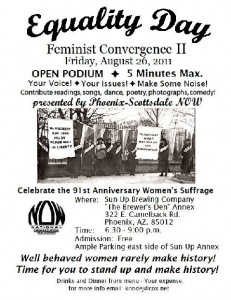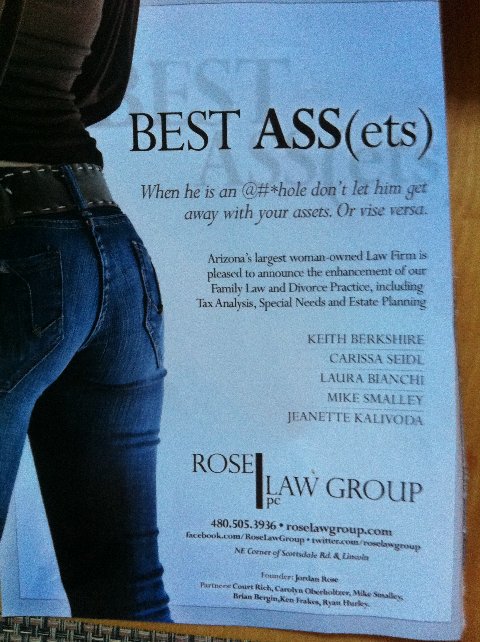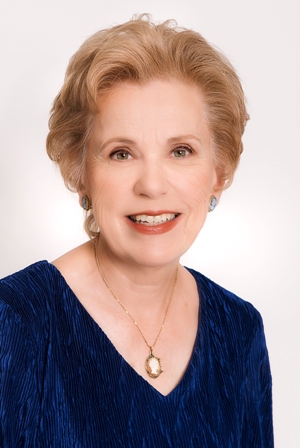 Note: This is posted today as a Women’s Media Center Exclusive
Note: This is posted today as a Women’s Media Center Exclusive
The invitation to today’s Phoenix-Scottsdale National Organization for Women (NOW) “Equality Day Feminist Convergence” depicts a quaint sepia photo of suffragists picketing the White House. It telegraphs “old.” After all, the event celebrates the 91st anniversary of the date in 1920 when women’s right to vote entered the U.S. Constitution.
But, remember, in the decades at the beginning of the 20th century those purple and white sashes and those picket signs wielded by (purposefully) demurely dressed women were new media in action.
Fittingly, attendees at the Arizona event will have a contemporary victory to celebrate, one involving media activism squarely in the suffragist tradition. But this one is powered by e-mail and concerns itself with very modern day attire. Tight jeans to be exact.
It started when Scottsdale author Marcia Fine spotted this ad in local magazines:
“Do you think it’s sexist?” Fine rhetorically queried friends via e-mail.
When Fine’s question landed in Paula Cullison’s inbox, she answered a resounding “Yes!” And she took action.
“Within minutes,” said the New York-born Cullison, who founded the nonprofit Arizona Women’s Partnership in 2002 to assist under-served women and children at risk in her adopted state, “I was on the Rose Law Firm website where I found the e-mail addresses of the lawyers mentioned in the ad. I sent them an e-mail expressing my concern and requesting that they pull the ad … ASAP…and to let me know so that I could mention it at the forthcoming Women’s Equality Day event here in Phoenix.“
She included the event invitation and copied her friends, which is how I found out about it.
Within the hour, she received a return e-mail promising to pull the ad. Jordan Rose, replied that, “as founder of the largest Arizona law firm owned by a woman,” she had found the ad humorous, but in no way meant to offend anyone—and yes, Cullison could announce this result at the upcoming event.
From her website and media reports, Rose, 40, appears to be a fairly progressive woman in a unique Arizona style of Republican politics. Her practice touts among its specializations green construction, renewable energy, and advising medical marijuana providers. But I can speculate that like most people, her formal education included minimal information about the U.S. women’s movement start at the 1848 Women’s Rights Convention in Seneca Falls, NY. Or how it took 72 years of diligent organizing, continuous campaigning, and courageous speaking out—often being belittled or beaten or jailed as a result—before the 19th Amendment to the Constitution was adopted.
Susan B. Anthony and other sheroes of the early women’s movement would swell with pride that women like Rose now make up almost half of law school graduates, and even start their own firms as Rose has done. But they’d be equally shocked at today’s media objectification of women’s bodies. We’re so immersed in it, that often we can’t even see it.
But Cullison, who as a young woman was inspired by reading Betty Friedan’s The Feminine Mystique and hearing a lecture by Margaret Mead, not only recognized sexism but also took the action steps to call it out and take it down.
And this wasn’t the first time she launched successful media activism. The 68-year-old Cullison—honored in 1999 with a Susan B. Anthony Luminary Award by the Arizona Women’s Council—has long recognized the power of media to further women’s equality and advancement in all fields. Back in 1995, she spearheaded “The Year for All Arizona Women.” In addition to 55 events statewide, one result was publication by the state’s largest newspaper, the Arizona Republic, of its first ever newspaper supplement on Arizona women.
Three years ago, when she went to AOL’s American Greeting Cards to find a card in honor of the voting rights anniversary, she found instead a card deeming that date National Toilet Paper Day. Fuming, Cullison e-mailed ten of her friends, and told us how to e-mail American Greeting Cards. She asked us to do the same with ten of our friends.
It took over a year of calling and e-mailing, but she—or rather many women acting together at Cullison’s instigation—won that battle too. Here’s the card to prove it. (Tip: Blue Mountain has marginally better ones.)
Clearly, media activism has become every bit as important to continuing the advancement of women as any other form of political activity. The good news is no campaign contributions are required and you don’t even have to register to “vote.”
Just follow Paula Cullison’s example and you can influence media to eliminate sexism in four easy steps:
1. Notice it and name it. (A tip of Bella Abzug’s hat to Marcia Fine.)
To stay up on the latest activism news and alerts be sure to subscribe to the Women’s Media Center mailing list and the Name It Change It campaign , a collaboration of the Women’s Campaign Forum and WMC.
2. Communicate with the person who can change it. Simply e-mail the executive producer (TV, radio, film), writer or editor (print, web). Or as Cullison did with the Rose Law Firm, write directly to the advertiser. To leverage your impact, copy the company president or other “higher ups” if applicable. Be brief—one paragraph is fine. Be direct in stating what you want changed. I particularly loved that Cullison communicated consequences if the ad remained in print as well as a positive spin by offering to announce the ad’s withdrawal at the NOW event.
I keep a list of the major network heads’ e-mail addresses plus those of a few of the print and web outlets I am most likely to read. That way I can shoot off an e-mail without having to look up the address, and if I need to send to someone else at a news organization, I have the pro-forma for their e-mail addresses.
3. Share with others, both grassroots and grasstops, directly and on social media. Ask them to share with their friends and colleagues.
4. Escalate as necessary until you win. And don’t forget to tell the world when you do. This will raise media consciousness and help deter future sexist representations.
Promising five minutes at an open mike for anyone who wants to raise her—or his—voice, the Phoenix-Scottsdale NOW event seems a sweet reminder of women’s voting rights victory. When Cullison steps up to the mike, she’ll be demonstrating a powerful way we can honor the 91st anniversary of women’s voting rights: by being a media activist today.
Gloria Feldt
Latest posts by Gloria Feldt (Posts)
- This Blog is No Longer Active… - March 17, 2014
- Women’s Equality Day and the Civil Rights March - August 26, 2013
- Stuck? Change Your Relationship With Power - July 21, 2013







 "Female Writers Kicking Up Literary Dust"
"Female Writers Kicking Up Literary Dust"